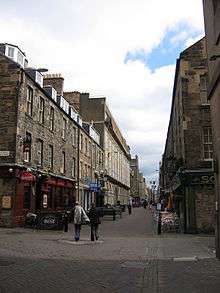Rose Street

Rose Street is a street in the New Town of Edinburgh, Scotland. It is a narrow street running parallel between Princes Street and George Street. Today, it is principally a shopping street, however, it is well known for containing a large number of bars and public houses.
History
Rose Street was built from 1770 to 1781 as a secondary street running east to west from St Andrew Square to Charlotte Square on the south side of George Street. Its name "Rose" is a counterpart to the road north of George Street, Thistle Street, representing the Rose of England and Thistle of Scotland, typical of the patriotic naming of the time. Originally built as three storey vernacular rubble houses it was not as grand as its surrounding streets. Built wholly as housing, by 1820 it was becoming a shopping street at ground floor. This change continued further and by the mid 20th century it was totally in shopping use (and also multiple bars). The nature of the street changing drastically in 1972 when multiple blocks were replaced by a standardised design, incorporating a projecting scalloped concrete canopy as part of an organised reconstruction by the Council, designed by Ian Burke Associates.[1]
Notable individual buildings include the "Kenilworth Bar" by Thomas P. Marwick (1899) and the Eagle Buildings by George Washington Browne (1905).[2]
The side lanes Rose Street Lanes North and Rose Street Lanes South act as service lanes to George Street and Princes Street respectively.
The street was pedestrianised in the 1980s.
Rose Street is also the home to the BT Rose Street Telephone Exchange, which connects much of the telecommunications infrastructure for the west side of the New Town of Edinburgh.[3]
Bars and drinking history
Rose Street was nicknamed the "Amber Mile" by tourism promoters (later dropped) due to the many bars and public houses along it. This was partly in reference to the Royal Mile, but was misleading since it is neither an English nor a Scots mile in length.
While some of the traditional pubs here have given way to ones with humorous names such as Dirty Dicks and Filthy McNastys, in keeping with its many Walter Scott references, Rose Street in Edinburgh has a bar called the "Kenilworth", along with one named after Scott's house, the "Abbotsford". Milne's Bar, also has literary connections, with one of its rooms nicknamed the "Little Kremlin", because many members of the Scottish Renaissance such as Hugh MacDiarmid would meet there. Pictures of various Scottish poets appear on the walls.
Rose Street, along with the history, is also famed for a rare drinking game. This game, named the Rose Street Challenge, is not for the faint of heart. It involves making your way along Rose Street while having a drink in every bar/pub/restaurant on the way.[4]
Retail
Many of Princes Street's main shops have back entrances into Rose Street, including Jenners, Boots and Next. It is also a minor shopping street in its own right, with a number of small businesses on it, such as hairdressers, a small Sainsbury's which closes late, northern access to Marks & Spencer and BHS, record shops such as Fopp, CEX (second hand electrical goods store) and shoe shops and novelty shops.
The street also accommodates service lanes for businesses on Princes, George and Rose Streets.
See also
References
- ↑ Buildings of Scotland: Edinburgh, by Gifford McWilliam and Walker
- ↑ Buildings of Scotland: Edinburgh, by Gifford McWilliam and Walker
- ↑ http://www.telephone-exchange.co.uk/Edinburgh-Rose-Street-ESROS.html
- ↑ http://www.edinburgh-rosestreet.com/history.html
External links
Coordinates: 55°57′7.10″N 3°12′6.03″W / 55.9519722°N 3.2016750°W
